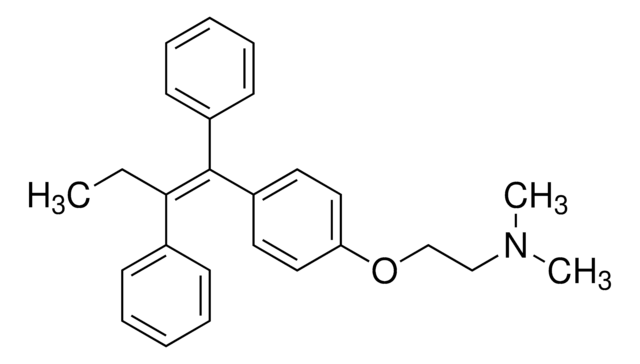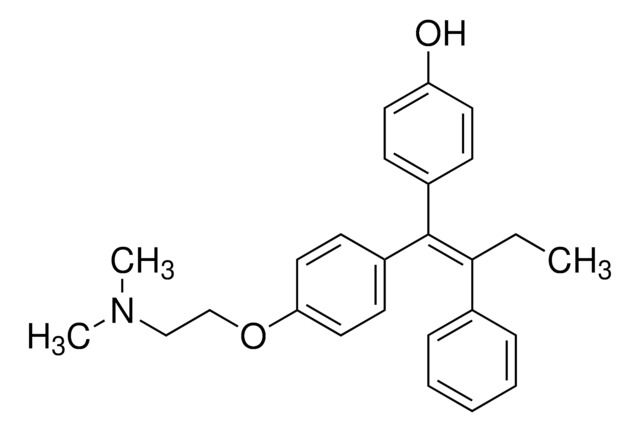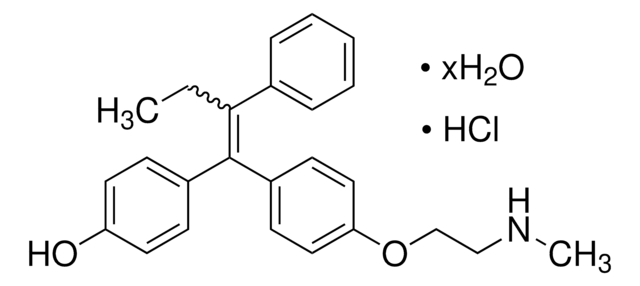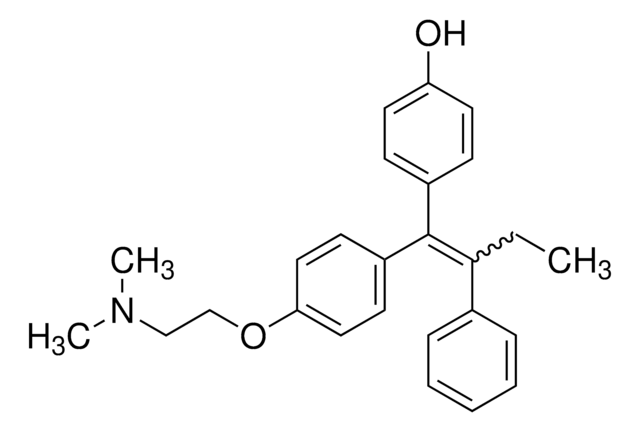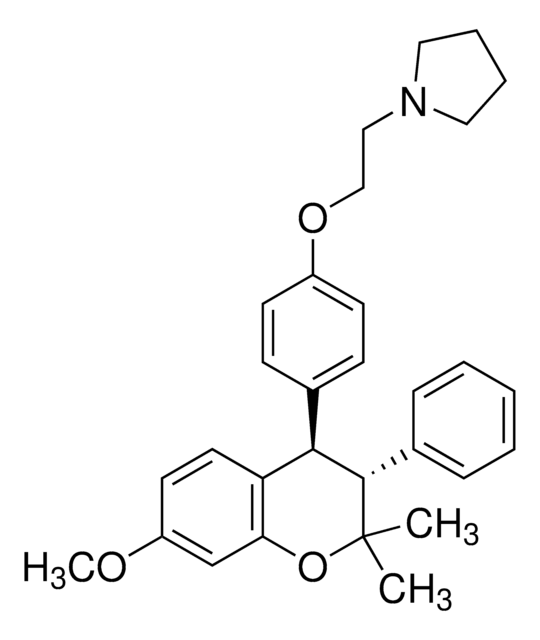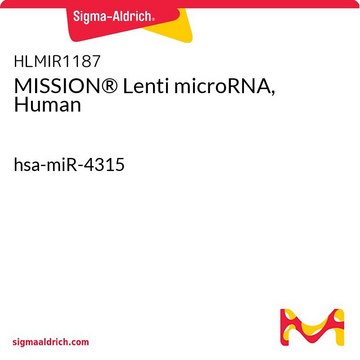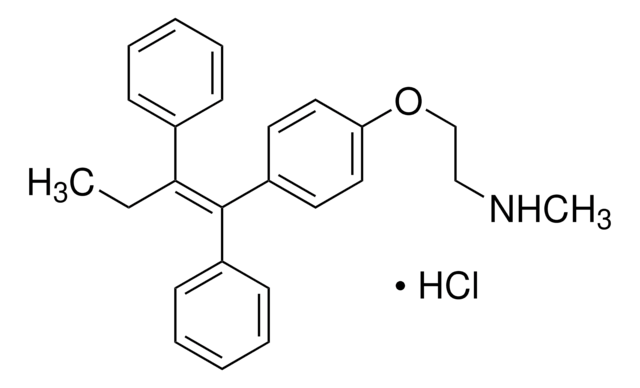推荐产品
方案
≥98% (HPLC)
表单
powder
颜色
white to beige
溶解性
DMSO: 2 mg/mL, clear
储存温度
2-8°C
SMILES字符串
N(CCOc1ccc(cc1)\C(=C(\CC)/c3ccccc3)\c2ccc(cc2)O)C
InChI
1S/C25H27NO2/c1-3-24(19-7-5-4-6-8-19)25(20-9-13-22(27)14-10-20)21-11-15-23(16-12-21)28-18-17-26-2/h4-16,26-27H,3,17-18H2,1-2H3/b25-24-
InChI key
MHJBZVSGOZTKRH-IZHYLOQSSA-N
应用
(Z)-Endoxifen has been used to demonstrate the lack of contribution of subventricular zone and leptomeningeal cells in a study determining the generation of neuroblasts from astrocytes.
生化/生理作用
(Z)-Endoxifen (endoxifen) is an active tamoxifen metabolite generated via actions of cytochrome P450 (CYP) enzymes CYP3A4/5 and CYP2D6. Endoxifen is more potent than tamoxifen as a selective estrogen receptor modulator (SERM) both in vitro and in vivo with good pharmacokinetics and oral availability (∼80% MCF-7 tumor growth inhibition with 4-8 mg/kg/day endoxifen or 20 mg/kg/day tamoxifen in mice via p.o.). Endoxifen also exhibits 4-fold higher PKC inhibitory potency than tamoxifen and can overcome tamoxifen resistance due to cytochrome CYP2D6 polymorphism.
警示用语:
Danger
危险声明
危险分类
Aquatic Acute 1 - Aquatic Chronic 1 - Carc. 1A - Repr. 1B
储存分类代码
6.1C - Combustible acute toxic Cat.3 / toxic compounds or compounds which causing chronic effects
WGK
WGK 3
闪点(°F)
Not applicable
闪点(°C)
Not applicable
从最新的版本中选择一种:
分析证书(COA)
Lot/Batch Number
Phyllis Elkins et al.
Journal of pharmaceutical and biomedical analysis, 88, 174-179 (2013-09-24)
(Z)-Endoxifen (4-hydroxy-N-desmethyltamoxifen), an active metabolite generated via actions of CYP3A4/5 and CYP2D6, is a more potent selective estrogen receptor modulator (SERM) than tamoxifen. In the MCF-7 human mammary tumor xenograft model with female athymic mice, (Z)-endoxifen, at an oral dose
Paul Chen et al.
Cellular & molecular biology letters, 23, 3-3 (2018-01-09)
Endoxifen, an active metabolite of tamoxifen, has been shown to be an effective anti-estrogenic agent in estrogen receptor-positive breast cancer patients. In melanoma, estrogen receptor expression is shown to be associated with disease progression. However, the therapeutic benefit of endoxifen
Vered Stearns et al.
Journal of the National Cancer Institute, 95(23), 1758-1764 (2003-12-05)
Tamoxifen, a selective estrogen receptor modulator (SERM), is converted to 4-hydroxy-tamoxifen and other active metabolites by cytochrome P450 (CYP) enzymes. Selective serotonin reuptake inhibitors (SSRIs), which are often prescribed to alleviate tamoxifen-associated hot flashes, can inhibit CYPs. In a prospective
Janina Johänning et al.
Archives of toxicology, 92(3), 1099-1112 (2017-12-30)
Tamoxifen, a standard therapy for breast cancer, is metabolized to compounds with anti-estrogenic as well as estrogen-like action at the estrogen receptor. Little is known about the formation of estrogen-like metabolites and their biological impact. Thus, we characterized the estrogen-like
Ateeq Ahmad et al.
Breast cancer research and treatment, 122(2), 579-584 (2010-01-07)
Endoxifen is the key active metabolite of tamoxifen, a widely used breast cancer drug. Orally administered tamoxifen, is extensively metabolized by cytochrome P450 (CYP) enzymes, namely CYP3A4 and CYP2D6, into active metabolites, especially endoxifen. Due to genetic polymorphism of CYP2D6
我们的科学家团队拥有各种研究领域经验,包括生命科学、材料科学、化学合成、色谱、分析及许多其他领域.
联系技术服务部门